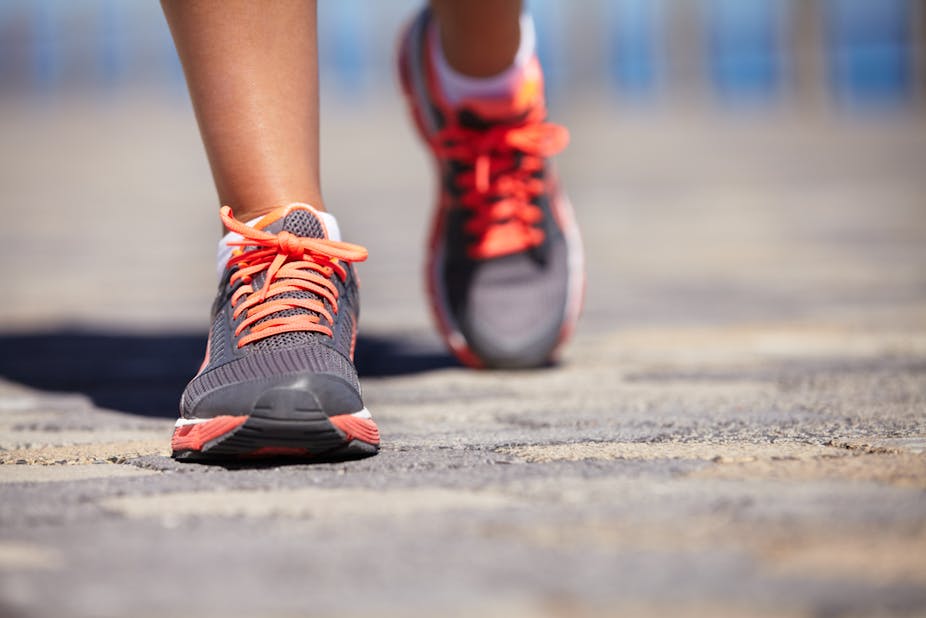The value of regular physical activity to a person’s well-being is unequivocal. But how much exercise do we need to maintain health, improve fitness or lose weight? And where is the line between healthy and harmful?
To maintain a healthy weight, Australia’s dietary guidelines recommend adults do at least 30 minutes of moderate intensity physical activity – such as brisk walking, social tennis or swimming – on most days. But if we want to lose weight, and don’t cut back on food and drink, we need to do more.
The American College of Sports Medicine agrees adults should get at least 150 minutes of exercise a week, though it explains this might be 20 to 60 minutes of vigorous exercise – which makes you huff and puff, such as jogging, aerobics, football and netball – three days a week.
The College guidelines also prescribe the quantity and and quality of exercise for developing and maintaining cardiorespiratory, musculoskeletal and neuromotor (or functional) fitness in healthy adults:
For flexibility, adults should do stretching exercises at least two days a week, with each stretch being held for ten to 30 seconds, to the point of tightness or slight discomfort
For resistance training, adults should train each major muscle group two or three days a week
For cardiovascular fitness, people should gradually increase the time, frequency and intensity of their workout.
The adage that if a little bit of exercise is good for me, then more should be better, still pervades the fitness industry. As does the “no pain, no gain” myth, which came to prominence in the early 1980s via Jane Fonda aerobic workout videos. Fonda would also urge viewers to “feel the burn” and exercise beyond the point of reasonable physical stress. These days the “no pain, no gain” motto is used to show that physical development is the result of training hard.
We often judge the efficacy of our workouts by our level of soreness the next day. This type of pain is called delayed onset muscle soreness or DOMS and occurs a day or two after exercise. It is most frequently felt when you begin a new exercise program, change your routine, or dramatically increase the duration or intensity of your workout. DOMS is a normal response to unusual exertion and is part of the body’s adaptation process that leads to increased strength or endurance as muscle recover and hypertrophy.
But while discomfort is natural if you push yourself, pain is the body’s protective mechanism, warning us to ease the intensity or protect an injured part of the body. Resisting this warning risks damaging tissue and may cause your body to over-compensate with other movements that can aggravate the injury and lengthen healing time. It’s also likely to reduce your motivation to continue exercising.
Pain during exercise can also indicate underlying health problems and should be seen as a signal to stop exercising and seek professional advice:
- Chest pain during exercise is a red flag for potential heart problems
- Exercise-induced bronchospasm (a sudden constriction of the bronchial muscles), even in non-asthmatics, may indicate an underlying respiratory problem
- Joint pain may result from osteoarthritis or indicate meniscal (knee) injury, ligament or tendon microdamage.
If you do find yourself sore after a tough workout or competition, try some low-impact aerobic exercises to maintain your blood flow during warm-down. Other remedies such as massage, ice baths and the RICE (rest, ice, compression, elevation) combination may also ease muscle soreness.
In terms of medication, non-steroidal anti-inflammatory drugs (such as aspirin, ibuprofen) can temporarily help reduce the effects of muscle soreness, though they won’t speed-up healing.
It’s certainly not easy building up your fitness or losing weight but the “no pain, no gain” motto is based less on the science of exercise physiology than on outdated sports psychology; it’s a recipe for injury.
When you feel pain during exercise, stop what you’re doing and take stock of how you’re feeling. If you think you can, try returning to the activity you were doing, but if the pain persists, then stop for good.

